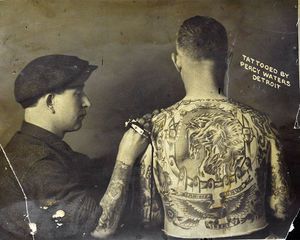Tattoo History | Percy Waters | Atlanta Tattoo Shop
Born in 1888 in eastern Alabama in the small town of Anniston, Percy Waters is undoubtedly one of the most innovative and inventive forefathers of modern western tattooing setting precedence for many of today's standards whether it be to with machine building and manufacturing or they way in which he applied his bold and striking tattoos.
According to different testimonies Waters was introduced to tattooing through the circuses and carney folk that would frequent his hometown. While working as a molder Waters became enamored with tattooing and he eventually acquired a tattoo machine and equipment from an alleged unknown source and began tattooing friends and locals as a pastime of his. He started traveling to visiting other tattoo artists but would always find himself back in Anniston.
Tattooing being the seedy underground subculture that it was back in the early 20s Waters found himself to have had tattooed the wrong individual and had to cease operations and flee his hometown. After a brief stay in New York Waters took up residence in Detroit Michigan until the 30s where he tattooed the sideshow attractions that had initially sparked his interest in the craft, carneys such as Egbertus Jan “Dutch” Berghege and Clyde Williams among others adorned extremely impressive and elaborate bodysuits that were way of ahead of their times.
Percy was a well versed tradesman and even though he had gained merit among his peers he was a modest man and billed himself “Just a Good Tattooer” and he was.
Percy Waters would go onto established probably the largest tattoo supply company in the world through the 1920s and 1930s. He designed and manufactured fourteen frame styles and patented what would become the first modern tattoo machine, in terms of frame geometry, on Aug. 13th 1929.
This tattoo machine design, and the thirteen others are still in use today. Employing simple variations such as the angle of the contact screw; this is at the top of the machine and comes into contact with the springs determining the depth of the needle stroke, gave rise to a range of machines which can achieve different results when tattooing.
From Edison's puncturing machines of 1875, it took almost fifty-five years before someone figured out a tattoo machine could be adjusted and perhaps one needle depth was not always what the design needed to be tattooed successfully.
The shape, size and angles associated with the frame of the tattoo machine have a profound effect on the efficiency and performance of that machine.
Percy Waters set the bar for today's tattoo machines in an unprecedented manner, the on/off switch that appeared on his patented machine has since disappeared; it was right on top of the tube grip and could be pushed with the index finger. Early on tattoo machines were not designed to be taken apart and cleaned. The tubes or barrels were frequently welded into place. Tube vices were a later development, and well in use by Percy Waters time.
It would be fifty years before another tattoo machine patent was granted by the U.S. Patent Office and in that time tattooing legends took the basic Waters designs and made them their own. Paul Rogers, Norman "Sailor Jerry" Collins, Milton Zeis, Owen Jensen and Bill Jones tweaked and tuned and turned them out by the score. Most of these designs are in production today. All of the originals are solid, workable instruments and highly collectible.
In conclusion one can see that Percy Waters went from being a local tradesman to propeling tattooing through the turn of the century by mechanizing and patenting what is essentially the modern tattoo machine, in short those we sit on the shoulders of those that came before us, we owe it to our forefathers to respect and honor the craft by being inventive and push the boundaries of our work because at the end of it all we all ride the coattails of those that came before us.





